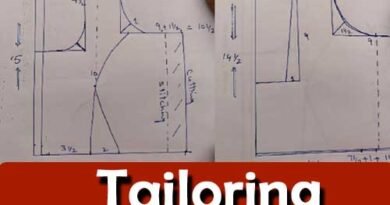Umbrella Cut Skirt
The umbrella skirt, also known as the umbrella or circle skirt, is a classic and versatile garment characterized by its wide, flowing silhouette that resembles the shape of an umbrella or circle when laid flat. In this class, we will explore the history, design elements, fabric choices, pattern drafting, sewing techniques, and styling tips for creating umbrella skirts. Whether you’re a beginner or an experienced sewist, mastering the art of making umbrella skirts will add a timeless and elegant piece to your wardrobe.
1. Introduction to Umbrella Skirt
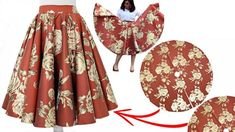
Overview:
- Silhouette: The umbrella skirt is characterized by its full and flared shape, achieved by using a circular or semi-circular pattern.
- Versatility: It can be styled for various occasions, from casual outings to formal events, depending on the fabric and finishing details.
- Comfort: Known for its comfort and ease of movement due to its generous width and flowing drape.
2. History and Evolution
A. Origins:
- The umbrella skirt has roots in traditional ethnic clothing from various cultures around the world.
- It gained popularity in Western fashion during the mid-20th century as part of the “New Look” introduced by Christian Dior in 1947, emphasizing a feminine and voluminous silhouette.
B. Modern Adaptations:
- Today, the umbrella skirt remains a staple in fashion, adapted to contemporary styles and preferences.
- Designers often incorporate various lengths, fabrics, and embellishments to suit current trends while maintaining its classic appeal.
3. Design Elements
A. Silhouette
1. Fullness:**
- The skirt is designed to have a full and flowing silhouette, achieved through a circular or semi-circular pattern.
- Fullness can vary depending on the desired volume and fabric weight.
B. Waistband
1. Waistband Types:
- Straight Waistband: A simple straight band that sits at the natural waistline.
- Contoured Waistband: Shaped to follow the curve of the waist for a more tailored fit.
- Elastic Waistband: Provides comfort and flexibility, ideal for casual wear.
C. Length
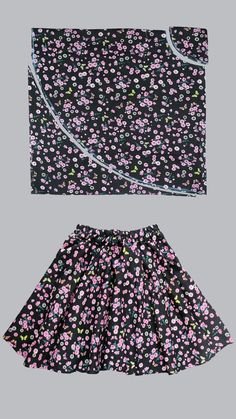
1. Length Variations:
- Mini: Above the knee, offering a youthful and playful look.
- Midi: Below the knee, suitable for both casual and semi-formal occasions.
- Maxi: Ankle-length or floor-length, often chosen for formal events or evening wear.
D. Closure
1. Closure Options:
- Invisible Zipper: Typically located at the center back seam for a seamless look.
- Button Closure: Adds a decorative element while securing the waistband.
- Elastic Waist: Pull-on style with an elasticated waistband for comfort and ease of wear.
4. Materials and Fabric Choices
A. Fabrics
1. Lightweight Fabrics:
- Cotton: Breathable and comfortable for everyday wear, available in various prints and solids.
- Linen: Offers a crisp texture and natural cooling properties, perfect for summer skirts.
- Rayon: Soft and draping, suitable for achieving a fluid drape in the skirt.
B. Medium to Heavyweight Fabrics
1. Wool: Provides warmth and structure, suitable for winter or cooler climates.
- Silk: Luxurious and smooth, ideal for formal umbrella skirts with a flowing drape.
- Brocade or Jacquard: Adds texture and richness, perfect for special occasions or evening wear.
C. Print and Pattern
1. Solid Colors: Classic and versatile, allowing the focus to be on the silhouette and design details.
- Prints: Floral, geometric, or abstract prints can add interest and personality to the skirt.
- Stripes or Checks: Create visual interest and play with directional patterns in the circular skirt design.
5. Pattern Drafting and Cutting
A. Using Commercial Patterns
1. Choosing a Pattern:
- Select a commercial pattern for umbrella skirts available from sewing pattern companies.
- Consider the desired length, waistband style, and closure method specified in the pattern.
B. Drafting Your Own Pattern
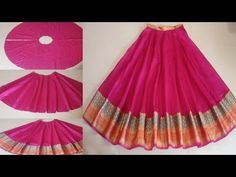
1. Measurements:
- Take accurate body measurements, including waist circumference, hip circumference, and desired skirt length.
- Calculate the radius for the waistline and hemline based on the desired fullness of the skirt.
2. Drafting Steps:
- Draw a quarter-circle or half-circle on pattern paper using a compass or drafting tools.
- Add seam allowances (typically ⅜ inch or 1 cm) to all edges for sewing.
- Cut out the pattern pieces along the marked lines.
6. Sewing Techniques
A. Seam Construction
1. Side Seams:
- Sew side seams together, matching raw edges and ensuring the fit is even.
- Finish seams with a zigzag stitch, serger, or French seams for a clean interior finish.
B. Waistband Attachment
1. Attaching the Waistband:
- Align and sew the waistband to the skirt top edge, ensuring the waistband is evenly distributed.
- Finish raw edges and press seam allowances towards the waistband.
C. Hemming
1. Hem Finish:
- Turn up the hem allowance and sew a narrow hem using a straight stitch or blind hem stitch.
- Press the hem to ensure it hangs evenly and maintains the skirt’s circular shape.
D. Closure and Finishing Touches
1. Adding Closure:
- Insert an invisible zipper or sew buttonholes and attach buttons to secure the waistband.
- For elastic waistbands, insert and secure the elastic within the waistband casing.
2. Final Pressing:
- Press the finished skirt with an iron to smooth out any wrinkles and creases.
- Ensure all seams are pressed open or to the side for a professional finish.
7. Styling Tips
A. Casual Wear
1. T-Shirt or Tank Top: Pair with a fitted T-shirt or tank top for a relaxed and effortless look.
- Denim Jacket: Layer with a denim jacket for added warmth and a casual vibe.
B. Semi-Formal Wear
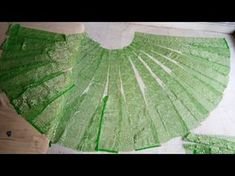
1. Blouse or Button-Up Shirt: Tuck in a blouse or button-up shirt for a polished and put-together outfit.
- Cardigan or Blazer: Add a cardigan or blazer for a sophisticated touch suitable for office wear or meetings.
C. Formal Wear
1. Silk Blouse: Style with a silk blouse for a luxurious and elegant ensemble perfect for evening events.
- Statement Jewelry: Enhance the outfit with statement jewelry such as earrings or a necklace for added glamour.
8. Care and Maintenance
A. Washing Instructions:
- Follow fabric care instructions to maintain the integrity and color of the skirt.
- Machine wash or hand wash skirts as per fabric type and construction details.
B. Storage:
- Hang skirts on padded or wooden hangers to preserve their shape and prevent wrinkles.
- Store skirts in a cool, dry place away from direct sunlight to avoid fading and damage to the fabric.
9. Troubleshooting and Tips for Success
A. Fit Adjustments:
- Make fit adjustments during the sewing process, such as taking in or letting out seams for a tailored fit.
- Check the fit of the waistband and adjust elastic or closure as needed for comfort.
B. Tips for Success:
- Practice sewing basic seams and techniques on scrap fabric before starting on the actual skirt.
- Take your time with pattern cutting and sewing to ensure accurate construction and a professional finish.
Conclusion
The umbrella skirt is a timeless and flattering garment that offers comfort, style, and versatility for various occasions. By understanding the design elements, fabric choices, pattern drafting, sewing techniques, and styling options covered in this class, you can confidently create umbrella skirts tailored to your personal style and fit preferences. Whether sewing for everyday wear, special occasions, or as a creative project, mastering the art of making umbrella skirts allows you to explore your creativity and enhance your sewing skills. Embrace the elegance and charm of the umbrella skirt as you embark on creating beautiful and functional garments that will become wardrobe favorites. Enjoy the journey of sewing and styling umbrella skirts to reflect your unique fashion sensibilities!
